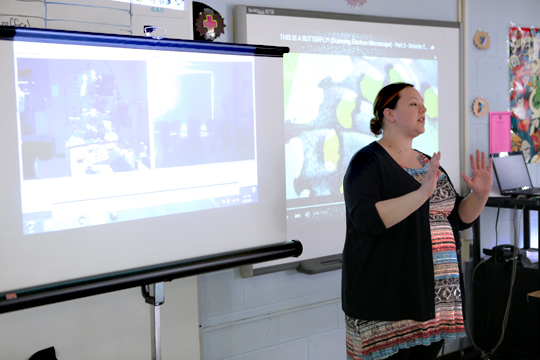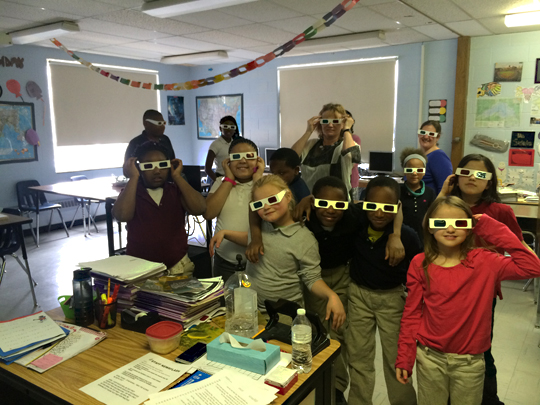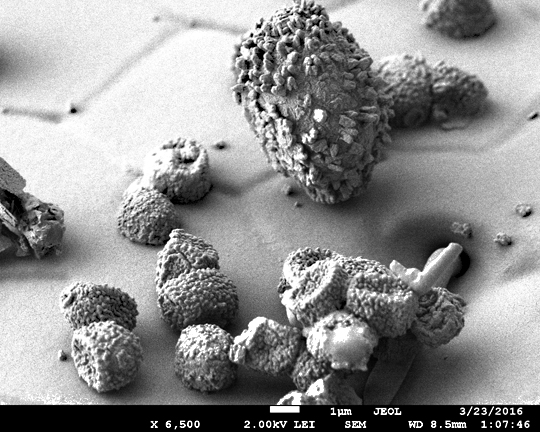Students in grades three to 12 have a fascinating opportunity to see the world at micro-level thanks to The University of Toledo’s SCOPE program.
SCOPE stands for Scientists Changing Our Pre-college Education. The program, started in 2011, has expanded to almost 80 sessions in about 20 schools, one teacher virtually using UT’s scanning electron microscope from as far away as Atlanta. The program began with a grant given by the National Science Foundation, which went toward the microscope used in many of the programs, in addition to promoting the scientific research at the University.

Cassandra Pittman, UT student and SCOPE project manager, explained to students at Summit Academy how they could use the University’s scanning electron microscope from their school.
The students used an almost $500,000 scanning electron microscope to look at samples such as the heads of various insects, spores from organic matter, and bacteria. Students examined the specimens, loaded and introduced by Dr. Pannee Burckel, scientific instrument specialist in the UT Chemistry Department, at the lab on campus, as they were projected on the Smartboard in the classroom. At one point, the children wore 3D glasses to help them analyze the images from the microscope.

Students at Summit Academy wore 3-D glasses to view images created using UT’s scanning electron microscope. Dr. Kristin Kirschbaum, director of the UT Instrumentation Center and creator of SCOPE, is in the center in the back row.
Cassandra Pittman, UT student and SCOPE project manager, taught students how they could use the microscope from their classroom. Within SCOPE, Pittman also is responsible for reaching out to schools about the program, preparing samples, teaching sessions, and creating lesson plans. Each program is designed in conjunction with the teachers at the school based on the class focus.
Samples inserted into the chamber of the cyber-enabled microscope in the Instrumentation Center can be seen on screens controlled by students in any classroom, no matter how far away the school. Through SCOPE, students gain exposure to the research done at UT, the opportunity to see cells and nuclei outside the pages of the textbook, and the ability to use the expensive equipment available at the University from the comfort of their classrooms.

This image was taken by a Summit Academy student with the scanning electron microscope and shows several types of pollen on the eye of a ladybug.
Dr. Rafael Garcia-Mata, assistant professor of biological sciences, led one of these high school-oriented sessions in April. Garcia-Mata spoke to students at Northwood High School as they examined the HeLa cell, made viewable thanks to the confocal microscope.
The HeLa cell was the first of what is known as the immortal cell line, meaning they can be examined now, 65 years after the initial collection from Henrietta Lacks in 1951. Students at Northwood read a book on Lacks and the unlawful extraction of this cell and, as part of a school project uniting English and science, had the opportunity to view samples of the cell at UT.
“Many Nobel Prizes were awarded based on work done on the HeLa cell,” Garcia-Mata said.
Students using this equipment through the UT SCOPE Program also can see what Dr. Tomer Avidor-Reiss and his student, Atul Khire, saw when they discovered a new structure in fruit fly sperm called the PCL. For younger kids, the lessons are all about the discovery, while older students are taught the value of the stories behind the findings.
“Telling the students the story behind the discovery of what they see with their own eyes in the SCOPE program helps them to experience the triumph of science and imagine if they would like to be part of something similar in the future,“ Avidor-Reiss, associate professor of biological sciences, said. “One of our goals is to fascinate the students; not enough people go into the sciences.”
For more information on the SCOPE program, click here or go to facebook.com/UTSCOPE.